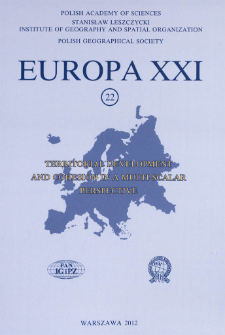
Obiekt
Tytuł: Quality of Life and Ecosystem Services in Rural-Urban Regions
Inny tytuł:
Wydawca:
Miejsce wydania:
Opis:
Typ obiektu:
Bibliografia:
1. Bertalanffy von L., 1928, Kritische Theorie der Formbildung, Gebrüder Borntraeger, Berlin.
2. Bolund P., Hunhammar S., 1999, Ecosystem services in urban areas, Ecological Economics, 29,291-301.
http://dx.doi.org/10.1016/S0921-8009(99)00013-0 -
3. Boyd J., Banzahaf S., 2007, What are ecosystem services?, Ecological Economics, 63, 1-2, 616-626.
http://dx.doi.org/10.1016/j.ecolecon.2007.01.002 -
4. Degórska B., 2008, Changes in the landscape of the Warsaw Metropolitan Area in the late 20th andearly 21st centuries, Atlas Warszawy, 10, IGiPZ PAN, Warszawa.
5. Degórski M., 2003, Some aspects of multifunctional landscape character in the interdisciplinaryenvironmental study, in: Helming K., Wiggering H., (Eds.), Sustainable development of MultifunctionalLandscapes, Springer–Verlag, Berlin, Heidelberg, New York, pp. 53 – 65.
http://dx.doi.org/10.1007/978-3-662-05240-2_4 -
6. Degórski M., 2005, Physical environment versus geographical environment, in: Maik W., RembowskaK., Suliborski A. (Eds.), Geography as a science linked to the space, environment andlandscape, pp. 116-129.
7. Degórski M., 2007, Environmental conditions as a driving force of regional development in Poland,in: Kovacs A. (Eds.), Regionality and/or Locality, Discussion Papers, Special Issue, Center forRegional Studies of Hungarian Academy of Sciences, Pecs, 2007, pp. 67-80.
8. Degórski M., 2010, Wielofunkcyjność przestrzeni przyrodniczej szansą zwiększenia potencjałurozwoju regionów poprzez grawitację atraktorów i wzrost lepkości, (Multifunctionality ofenvironment as a chance for the region development by attractors gravity and increase in theirviscosity), in: Strzelecki Z., Legutko-Kobus P. (Eds.), Oblicza współczesnego kryzysu a polskieregiony, Ministerstwo Rozwoju Regionalnego, Warszawa, pp. 180-187.
9. Domański R., 2007, Przewidywalność i modelowanie rozwoju zrównoważonego (podtrzymywalnego)w długim okresie, (Predictability and modeling of sustainable development in long term), in:Streszczenia Konferencji Naukowej, O nowy kształt badań regionalnych w geografii i gospodarceprzestrzennej, Poznań 19-20 listopada, Instytut Geografii Społeczno-Ekonomicznej i GospodarkiPrzestrzennej UAM, Komitet Przestrzennego Zagospodarowania Kraju PAN, Centrum InstytutWielkopolski UAM, Poznań, pp. 1-5.
10. Ehrlich P.R., Ehrlich A.H., 1991, Extinction, Ballantine, New York.
11. Farber S.C., Costanza R., Wilson M.A., 2002, Economic and ecological concepts for valuing ecosystemservices, Ecological Economics, 41, 375-392.
http://dx.doi.org/10.1016/S0921-8009(02)00088-5 -
12. Fisher B., Turner K., 2008, Ecosystem services: classification for valuation, Biological Conservation,141, 2008, 1167-1169.
http://dx.doi.org/10.1016/j.biocon.2008.02.019 -
13. Haughton G., Hunter C., 1994, Sustainable cities, regional policy and development, Jessica Kingsley,London.
14. Holdren J.P., Ehrlich P.R., 1974, Human population and the global environment, American Scientist,62, 282-292.
15. Howarth R., Farber S.C., 2002, Accounting for the value of ecosystem services, Ecological Economics,41, 421-429.
http://dx.doi.org/10.1016/S0921-8009(02)00091-5 -
16. Łaguna T., 2004, Ekonomiczne podstawy zarządzania środowiskiem i zasobami naturalnymi,(Economical bases for the environmental and natural resources management), Ekonomiczne iEkologiczne Aspekty Gospodarki Przestrzennej, Olsztyn.
17. Meyer B., Degórski M., 2007, Integration of multifunctional goals into land use – the planningperspective, in: Mander U., Wiggering H., Helming K. (Eds.), Multifunctional Land Use, meetingfuture demands for landscape goods and services, Springer, Berlin, Heidelberg, New York, pp.153-166.
http://dx.doi.org/10.1007/978-3-540-36763-5_10 -
18. Millennium Ecosystems, 2005, Assessment ecosystems and human well being synthesis, Island Press,Washington, DC.
19. Wallace K., 2007, Classification of ecosystem services: problems and solutions, Biological Conservation,139, 235-246.
http://dx.doi.org/10.1016/j.biocon.2007.07.015 -
20. Zhang W., Ricketts H., Kremen C., Carney K., Swinton M., 2007, Ecosystem service and dis-servicesto agriculture, Ecological Economics, 64, 253-260.
http://dx.doi.org/10.1016/j.ecolecon.2007.02.024 -
21. Życzkowski K., Łoziński A., 2003, Chaos, fraktale oraz euroatraktor, (Chaos, fractals and euroattractors),Foton, 80, 4-9.
Czasopismo/Seria/cykl:
Tom:
Strona pocz.:
Strona końc.:
Szczegółowy typ zasobu:
Format:
Rozmiar pliku 0,6 MB ; application/pdf
Identyfikator zasobu:
oai:rcin.org.pl:31091 ; 1429-7132 ; 10.7163/Eu21.2012.22.11
Źródło:
CBGiOŚ. IGiPZ PAN, sygn.: Cz.6406, Cz.6407 ; kliknij tutaj, żeby przejść
Język:
Prawa:
Prawa zastrzeżone - dostęp nieograniczony
Zasady wykorzystania:
Digitalizacja:
Instytut Geografii i Przestrzennego Zagospodarowania Polskiej Akademii Nauk
Lokalizacja oryginału:
Dofinansowane ze środków:
Unia Europejska. Europejski Fundusz Rozwoju Regionalnego ; Program Operacyjny Innowacyjna Gospodarka, lata 2010-2014, Priorytet 2. Infrastruktura strefy B + R
Dostęp:
Kolekcje, do których przypisany jest obiekt:
- Repozytorium Cyfrowe Instytutów Naukowych > Kolekcje Partnerów > Instytut Geografii i Przestrzennego Zagospodarowania PAN > Publikacje pracowników i Wydawnictw
- Repozytorium Cyfrowe Instytutów Naukowych > Kolekcje Partnerów > Instytut Geografii i Przestrzennego Zagospodarowania PAN > Biblioteka Instytutu > Serie/Czasopisma/Cykle
- Repozytorium Cyfrowe Instytutów Naukowych > Piśmiennictwo > Czasopisma/Artykuły
Data ostatniej modyfikacji:
2 paź 2020
Data dodania obiektu:
15 lip 2013
Liczba pobrań / odtworzeń:
1156
Wszystkie dostępne wersje tego obiektu:
https://rcin.org.pl/publication/50274
Wyświetl opis w formacie RDF:
Wyświetl opis w formacie RDFa:
Wyświetl opis w formacie OAI-PMH:
| Nazwa wydania | Data |
|---|---|
| Degórski M. - Quality of Life and Ecosystem Services in Rural-Urban Regions | 2 paź 2020 |
Obiekty Podobne
Degórski, Marek
Degórski, Marek
Degórski, Marek
Degórski, Marek
Degórski, Marek Kowalkowski, Alojzy
Affek, Andrzej Kowalska, Anna Regulska, Edyta Solon, Jerzy (1954– ) Degórska, Bożena (1956– ) Wolski, Jacek (1971– ) Degórski, Marek
Solon, Jerzy (1954– ) Degórski, Marek

 INSTYTUT ARCHEOLOGII I ETNOLOGII POLSKIEJ AKADEMII NAUK
INSTYTUT ARCHEOLOGII I ETNOLOGII POLSKIEJ AKADEMII NAUK
 INSTYTUT BADAŃ LITERACKICH POLSKIEJ AKADEMII NAUK
INSTYTUT BADAŃ LITERACKICH POLSKIEJ AKADEMII NAUK
 INSTYTUT BADAWCZY LEŚNICTWA
INSTYTUT BADAWCZY LEŚNICTWA
 INSTYTUT BIOLOGII DOŚWIADCZALNEJ IM. MARCELEGO NENCKIEGO POLSKIEJ AKADEMII NAUK
INSTYTUT BIOLOGII DOŚWIADCZALNEJ IM. MARCELEGO NENCKIEGO POLSKIEJ AKADEMII NAUK
 INSTYTUT BIOLOGII SSAKÓW POLSKIEJ AKADEMII NAUK
INSTYTUT BIOLOGII SSAKÓW POLSKIEJ AKADEMII NAUK
 INSTYTUT CHEMII FIZYCZNEJ PAN
INSTYTUT CHEMII FIZYCZNEJ PAN
 INSTYTUT CHEMII ORGANICZNEJ PAN
INSTYTUT CHEMII ORGANICZNEJ PAN
 INSTYTUT FILOZOFII I SOCJOLOGII PAN
INSTYTUT FILOZOFII I SOCJOLOGII PAN
 INSTYTUT GEOGRAFII I PRZESTRZENNEGO ZAGOSPODAROWANIA PAN
INSTYTUT GEOGRAFII I PRZESTRZENNEGO ZAGOSPODAROWANIA PAN
 INSTYTUT HISTORII im. TADEUSZA MANTEUFFLA POLSKIEJ AKADEMII NAUK
INSTYTUT HISTORII im. TADEUSZA MANTEUFFLA POLSKIEJ AKADEMII NAUK
 INSTYTUT JĘZYKA POLSKIEGO POLSKIEJ AKADEMII NAUK
INSTYTUT JĘZYKA POLSKIEGO POLSKIEJ AKADEMII NAUK
 INSTYTUT MATEMATYCZNY PAN
INSTYTUT MATEMATYCZNY PAN
 INSTYTUT MEDYCYNY DOŚWIADCZALNEJ I KLINICZNEJ IM.MIROSŁAWA MOSSAKOWSKIEGO POLSKIEJ AKADEMII NAUK
INSTYTUT MEDYCYNY DOŚWIADCZALNEJ I KLINICZNEJ IM.MIROSŁAWA MOSSAKOWSKIEGO POLSKIEJ AKADEMII NAUK
 INSTYTUT PODSTAWOWYCH PROBLEMÓW TECHNIKI PAN
INSTYTUT PODSTAWOWYCH PROBLEMÓW TECHNIKI PAN
 INSTYTUT SLAWISTYKI PAN
INSTYTUT SLAWISTYKI PAN
 SIEĆ BADAWCZA ŁUKASIEWICZ - INSTYTUT TECHNOLOGII MATERIAŁÓW ELEKTRONICZNYCH
SIEĆ BADAWCZA ŁUKASIEWICZ - INSTYTUT TECHNOLOGII MATERIAŁÓW ELEKTRONICZNYCH
 MUZEUM I INSTYTUT ZOOLOGII POLSKIEJ AKADEMII NAUK
MUZEUM I INSTYTUT ZOOLOGII POLSKIEJ AKADEMII NAUK
 INSTYTUT BADAŃ SYSTEMOWYCH PAN
INSTYTUT BADAŃ SYSTEMOWYCH PAN
 INSTYTUT BOTANIKI IM. WŁADYSŁAWA SZAFERA POLSKIEJ AKADEMII NAUK
INSTYTUT BOTANIKI IM. WŁADYSŁAWA SZAFERA POLSKIEJ AKADEMII NAUK


































